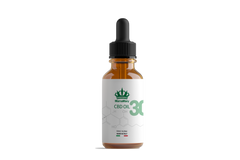Discovery of THCP: A New Cannabis Phytocannabinoid 30 Times More Potent than THC

We've heard a lot about CBD, THC, the psychoactive effect of the synthetic cannabinoid HHC and lately we've explored the unique properties of H4CBD .
A new cannabinoid that is 30 times more potent than THC was recently discovered; we are talking about THCP, which immediately sparked unprecedented interest in the scientific and medical community and adds to the long list of components of cannabis sativa that make the hemp plant unique and irreplaceable. This compound, identified by a team of Italian researchers, turned out to be a cannabinoid with a potential thirty times greater than THC, already well known for its psychoactive effects. This discovery offers new perspectives in cannabinoid research and potential therapeutic applications and pharmacological properties.
What is THCP and What is its Affinity for the CB1 Receptor?

THCP, or tetrahydrocannabiphorol, is a recently discovered cannabinoid found in the marijuana plant that has been shown to have an affinity for the CB1 receptor of the endocannabinoid system in the brain and central nervous system. This higher affinity compared to THC could explain the potentially more potent properties of THCP compared to THC.
The extraction of THCP is a process that therefore exploits its affinity for the CB1 receptor, which is similar to that of THC. This process may involve using solvents such as alcohol or supercritical carbon dioxide to extract cannabinoids from the cannabis plant. Once extracted and isolated, cannabinoids are separated and purified using techniques such as column chromatography or crystallization and can then be infused into oils for ease of intake. The objective is to obtain a concentrated and pure extract of THCP, avoiding contamination from other substances present in the plant. This extract can then be used for medicinal or research purposes, after passing rigorous quality and safety checks.
Potential Therapeutic and Clinical Applications: the Discoveries of Italian Researchers

The Italian research that led to the discovery of THCP was an important step forward in understanding cannabinoids and their properties. The team of Italian researchers, led by Giuseppe Cannazza, researcher at the Department of Life Sciences of the University of Modena and Reggio Emilia and associated researcher at the CNR NANOTEC in Lecce, identified this new cannabinoid during a study conducted on cannabis inflorescences.
The Italian study published in the journal Nature examined this molecule called Δ9-THCP, present in some varieties of cannabis, analyzing its pharmacological activity and potential medical benefits, comparing it with that of the well-known Δ9-THC. Using male mice and human cells in vitro transfected with CB1 and CB2 receptors, researchers found that Δ9-THCP has similar pharmacological activity to Δ9-THC, but with greater potency. This suggests that Δ9-THCP may interact with cannabinoid receptors in the human body more effectively than Δ9-THC. These findings are crucial for understanding the effects of cannabis and for the development of more potent and effective cannabinoid medicines.
This discovery was a real turning point in cannabinoid research, as it opened new perspectives to better understand the role of these compounds in the human body and how it can have therapeutic applications.
The Italian research has attracted the attention of the international scientific community and raised interest in further studies on cannabinoids and their effects. Thanks to the discovery of THCP, researchers now have a new target to explore the potential therapeutic properties of this cannabinoid and its interactions with the human body.
This research has demonstrated once again the importance of international collaboration and investment in scientific research. The discovery of THCP is a clear example of how the work of a team of researchers can lead to significant findings that have the potential to improve our understanding of health and medicine.
Is THCP Legal and Available on the Market?
An important question that many ask is whether THCP is legal and available on the market. Currently, THCP is not regulated like THC, which raises questions about its legal status and availability. However, with growing interest in THCP research, THCP products may emerge in the future.
Conclusions and Future Prospects

In conclusion, the discovery of THCP represents an important advancement in cannabinoid research and potentially opens new avenues in medicine and therapy. With a higher potency than THC and a safety profile that is still the subject of some research, it offers an interesting prospect in the field of medicinal cannabis. Compared to THC, THCP has been shown to have significantly higher potency, even at lower doses. Some varieties of medicinal cannabis may contain significant amounts of THCP, along with other varieties of phytocannabinoids such as CBDP, whose sensory role and effects on the body are still being studied.
Studies indicate that THCP may have more intense psychoactive potency than THC, but its longer side chain may also influence other sensory and psychophysiological aspects. Before THCP can be used medicinally, it is essential to carefully test its properties and evaluate any possible side effects. Its presence in cannabis resin could open new perspectives in the treatment of various medical conditions, but all responsibility must be taken in ensuring the safety and effectiveness of the treatments. Ultimately, THCP represents a promising area of research that could lead to new discoveries in the field of medicinal therapy.
What to Remember
- THCP is a new cannabinoid discovered by Italian researchers which has proven to be up to 30 times more potent than THC
- The use of THCP for therapeutic purposes is still being studied and further research is necessary to offer a complete picture of its potential and side effects
- Currently, THCP is not as regulated as THC, raising questions about its legality and availability on the market
















